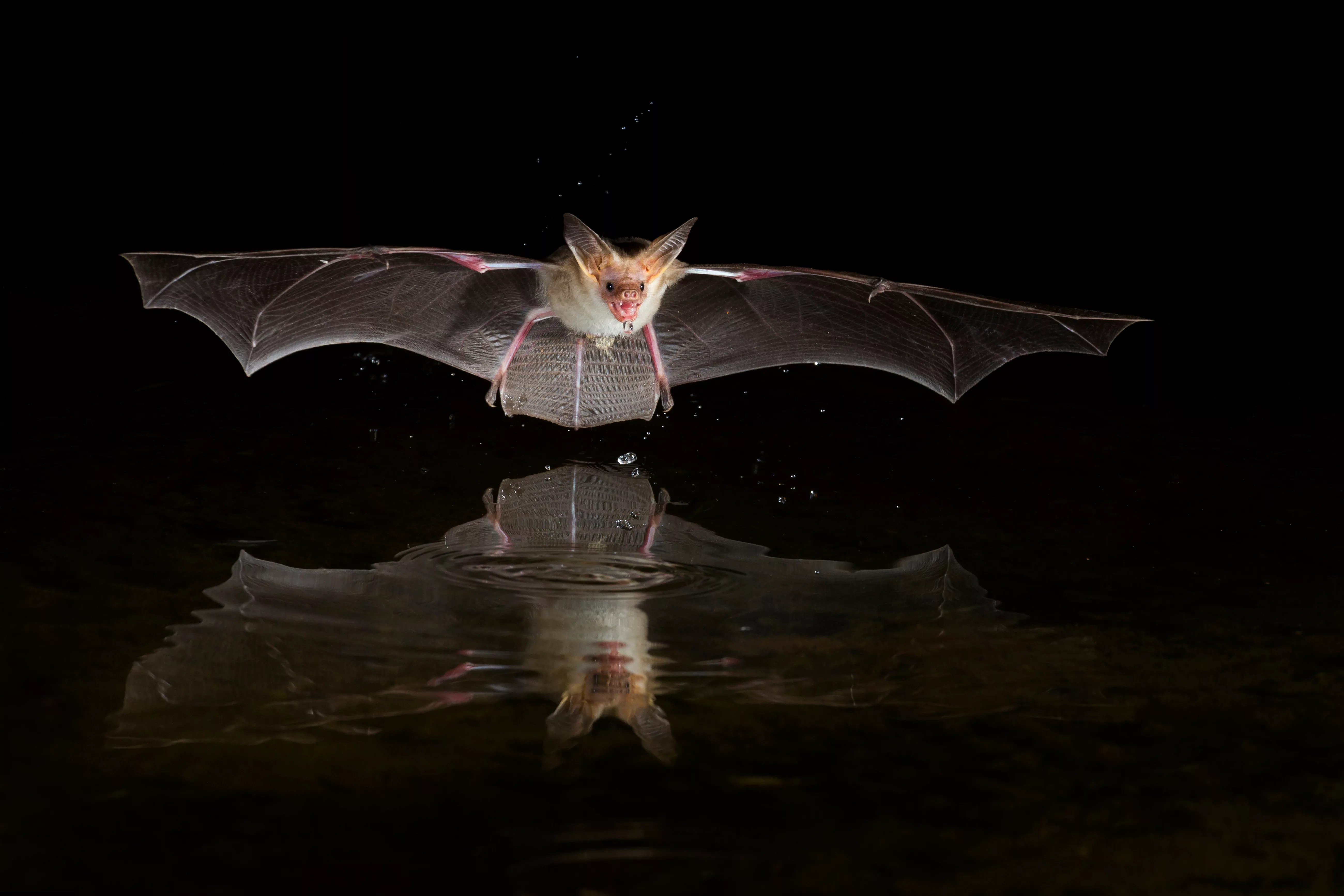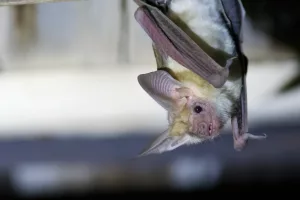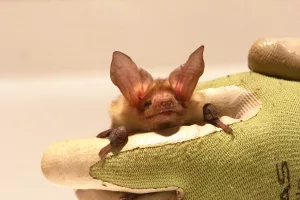
The pallid bat became California's official state bat in January 2024.
Winging its way through vineyards and farmlands in the North Bay and the state, consuming tons of crop-threatening pests, the pallid bat recently became California’s official state bat with the help of a Bay Area ecologist and a 12-year-old girl.
The pallid bat—a 3-to-5-inch-long critter with golden fur—became California’s official state bat Jan. 1, joining the ranks of the California poppy (state flower), grizzly (state bear), red-legged frog (state amphibian) and Augustynolophus morrisi (state dinosaur).
Dave Johnston, a wildlife ecologist from Saratoga, got the ball rolling in 2017. Johnston began campaigning for the pallid bat that year and got a Senate resolution passed in 2018, but COVID-19 stopped the progress—until a 12-year-old nature lover stepped in.
Naomi D’Alessio of Los Angeles became interested in bats when she and her father Matt took a class in California bat natural history at San Francisco State University in 2022. Her mother had worked on state Sen. Caroline Menjivar’s (D-Panorama City) campaign, so Naomi, who was 12 years old in 2023, had the senator’s ear.

And quicker than a bat out of hell, Menjivar joined Assemblywoman Celia Aguiar-Curry, whose 4th District encompasses most of Wine Country, in co-authoring SB 732 to grant official state recognition of Antrozous pallidus. Meanwhile, bat enthusiasts joined others—including Helena View Vineyards in Calistoga, owned by Johnston’s brother—in writing letters of support—and in January 2024, the pallid bat became California’s official state bat.
“Pallid bats live in California’s deserts, oak woodlands, coastal redwood forests, and high up into the pine forests of the Sierra Nevada mountains,” says a quote from SB 732, much of which was written by Naomi herself. And bats in general save farmers in California an estimated $1.3 billion per year, Johnston confirmed in a phone interview.
The wildlife ecologist, who has worked as a bat consultant with wineries including RustRidge Ranch & Winery in St. Helena, says pallid bats often forage in vineyards, especially organic vineyards.
The bats eat centipedes, wolf spiders and scorpions, pests all too common in vineyards, Johnston said.
Also, pallid bats eat the California root borer, another vineyard pest.
“It’s in the family of the longhorn beetle. They are about 2 inches long,” Johnston says. “The females lay about 200 eggs just below the surface of the soil near the roots of the grapevines. Those grubs feed on the roots of the grapevines, and pallid bats are one of the few bats that eat those regularly.”
Pallid bats roost in hidden havens like the eaves of porches, or inside a barn.
“They will roost in the ceiling of a barn at the apex of the ceiling. That’s very typical,” Johnston said.“They have little claws on their feet and when they relax, their tendons have a locking mechanism. They naturally have those little claws extended,” he says. “So, when their muscles are relaxed, they can hang by their feet from the rough wood.”
To pull their claws in, the bats actually have to tense their muscles—the opposite of, for example, a house cat, or Wolverine in the X-Men.
A conservation coordinator with the California Department of Fish and Wildlife was totally on board with the pallid bat’s new role.
“We have 25 bat species in California, and the pallid bat is one of the coolest,” says Katrina Smith, small mammal conservation coordinator for Fish and Wildlife.

It might not be easy for folks in the North Bay to know if pallid bats are occupying their porches or barns, she says.
“They fly really quickly. Most people don’t get a look at it, and it’s usually in low light. If it’s around sunset, it’s more likely to be a bat,” Smith says.
In summertime, the females form a sort of childcare cooperative, gathering in groups of 20 to 100 to raise their pups, and “you might find them in your barn,” she says.
The males tend to be solitary, she says, which certainly seems consistent with, for example, Batman.
All humor aside, there’s a serious bent to the pallid bat’s ascendency. Typically, bats raise just one pup a year. The low birth rate makes their populations vulnerable to disruptions such as humans encroaching on their habitat, as well as climate change, according to the California State Parks Foundation.
“As bat populations in California are rapidly declining, recognizing their role in the ecosystem becomes increasingly critical for their survival,” and for this reason, having a state bat is especially important, according to the foundation.
A Sonoma County organic farming pioneer was glad to hear of the development.
“Anytime you have a bat being recognized as an important part of the ecosystem it’s spectacular,” says Phil Coturri, founder of Enterprise Vineyards in Sonoma.
“We put up bat houses in our barns,” he says. “Anytime we can do integrated pest management—bats, owls, bluebird boxes in the vineyard—I’m all for it,” says Coturri.
The “bluebird boxes” comment refers to the fact that putting up nest boxes in vineyards can help provide habitat for bluebirds while helping growers keep pests off their grapes.
“Every morning, I wake up at 5 a.m. to feed our cats. This time of year it’s always amazing—I don’t know if they are pallid bats or not, but I have a bunch of bats that greet me as I feed the cats,” says Coturri, who is something of a legend in the annals of viticulture for his innovative organic farming practices across California terrain.
The timing is typical, according to wildlife ecologist Johnston. Bats have night roosts and day roosts, and they return to their day roosts around 5:30 a.m., when Coturri is feeding the cats.
Coturri isn’t the only North Bay organic aficionado pleased with the pallid bat’s new status.
“I love hearing this,” says Aron Weinkauf, winemaker and vineyard manager at Spottswoode Estate Vineyard & Winery in St. Helena.
“We are huge fans of bats. They are by far the best aerial predators of insects and we work to ensure that we are not disrupting the areas we know them to live in,” he says.
“We have hung bat boxes and have seen them used but not occupied. This means that the more natural homes are still the best,” Weinkauf says.



